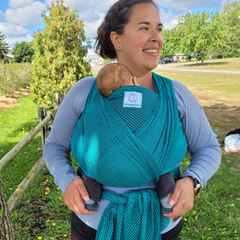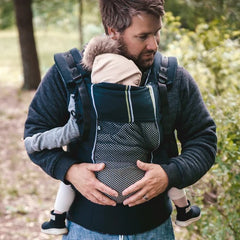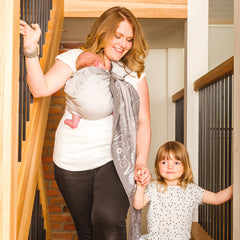3 Steps to Master Physiological Babywearing
If you have started getting interested in babywearing, for example, due to the arrival of a new baby, you might have heard of “physiological babywearing”. It’s a notion you need to understand and master before carrying your baby for the first time but which might seem obscure when we don’t know what it is.
Physiological babywearing is important for several reasons. One reason is that it promotes a healthy development of the baby’s spine and hips. In addition to this, children feel more comfortable and safe while being carried and get to fully enjoy all the benefits of babywearing.
In this article, we’ll be telling you more on what is a physiological babywearing position, how to do it, and the things you’ll need to achieve it. We’ll also be giving you tips on how to make sure, at a glance, that your baby is positioned correctly.
1. What is physiological babywearing?
The fundamental principles of physiological babywearing rest on a profound comprehension of the physiological and emotional needs of infants. Physiological babywearing conforms to a baby’s natural positioning, by which we mean how the baby was positioned during his time in his mother’s belly.
More specifically, here’s a quick description of a physiological position according to these principles:
- The lower back is rounded and the pelvis is tilted forward.
- The limbs are folded and close to the center of the body near the belly button.
- As to the baby’s head and neck, make sure to provide appropriate support, as a newborn’s neck muscles aren’t yet fully developed.
- The ankles should not be rotated in relation to the shins or thighbones.
- A note on the spread of the knees: The distance between the knees should always be wider than the hips with an ideal angle of about 90°. Having the baby’s legs too close together puts the hips at risk of luxation, a potential cause for dysplasia.
Now that you’re acquainted with its basic principles, we’ll share with you some tips on how to put them into practice.
2. What are your babywearing needs?
It’s important to define several things to determine what your needs are to make the best choice for your baby carrier or baby wrap:
- Your use: What are you going to use it for? Is it for breastfeeding? Will you be using it inside your house our when going out? Will you be doing sports like hiking?
- Putting it on: Do you want the simplest thing to use or are you willing to learn new skills and, let’s say, choose something that’ll require more practice?
- Weight and size: Do you need it to be lightweight and easy to carry or is it unimportant for your circumstances?
In terms of babywearing equipment, we have 2 main categories to explore: baby wraps and baby carriers. To learn more about these, read our article on the topic.
Starting from these categories, here are the most commonly used for physiological babywearing:
A traditionnal baby wrap is a long piece of fabric tied around the torso to support the baby’s body. Very versatile, it allows for a variety of carrying positions (in the front, back and hip). It adapts to different silhouettes and can be used from birth and until the child becomes too heavy to be carried. However, you’ll need to learn different ways of tying it to make use of it to the fullest. Another great perk of the baby wrap is the inequaled skin to skin contact experience it offers, which is highly beneficial to the baby.
A ring sling is a short baby wrap worn on a single shoulder and adjusted with two metal rings. As the baby grows up, it’s often used to carry on the hip. It’s easy and quick to put on in comparison to a traditional baby wrap. However, the baby’s weight can feel heavy as it rests on one shoulder, which can be less comfortable for babywearing for longer periods.
The Mei Tai is a hybrid between a baby wrap and a structured baby carrier. It’s made of a main panel tied around the wearer with long, padded fabric ties. It’s easier to use than a baby wrap due to the seating part being already created for the baby to be placed in. It also has a good variety of positions to carry a baby with.
A baby carrier, or structured baby carrier, has a padded belt and shoulder straps designed to be easy to put on without the need to learn any tying techniques. All Chimpäroo baby carriers can accommodate several carrying positions but some are more versatile than others.
Our favorite (are also the most versatile): the EvöAir bblüv baby carrier and the PöpNgo.
Another bonus with some baby carriers is that they have accessories that will bring your babywearing experience to a new level of comfort and more possibilities toward an ideal physiological carrying position. One of these is the EvöAir bblüv baby carrier, for which a lumbar support and a pair of leg supports are available.
Generally speaking, all quality baby carriers and baby wraps allow for proper physiological babywearing, but in order to ensure that you’ll make the perfect choice, it’s important to look up the product’s certifications and those of the people who have designed them. At Chimpäroo, our baby carriers and baby wraps have received accreditations from the International Hip Dysplasia Institute and the Oeko-Tex Standard. Finally, our baby carriers and baby wraps have been designed by Christine Duhaime, who has a degree in occupational therapy.
3. What are the best physiological babywearing positions?
To put your baby in a physiological position, the first step is to obey the principles we’ve presented you earlier (rounded back, folded legs, etc.). The Babywearing National Institute (INPE) explains the physiological babywearing of a newborn as such:
- Carry your baby high up on your torso (as in this picture): The advantages of this position are its increased level of comfort and the position’s efficiency in bringing your baby as close to you as possible, leaving no space between you. This makes a longer and more active babywearing experience much easier. In addition to this, your baby will feel safer when clinging to your chest and his airways will remain unobstructed.
- Carry your child in a crouching-sitting position (as in this picture): This position promotes the healthy development of the hips. Your child will be maintained in an instinctual and natural position and overall good for his spine.
A good and quick way to verify that your baby is in a proper physiological position is to ask somebody whether the legs, knees and bottom of your baby look like the letter ‘M’. From the side, a good position would look like the letter ‘C’ from the baby’s tilted pelvis.
************
We hope that with these tips, you will feel more confident in taking up babywearing and more precisely, physiological babywearing. You’ll see: it’s a great adventure!
More resources will help you in learning how to optimally position your baby physiologically:
- The videos on our YouTube channel will give you great demonstrations and advice.
- Several of our blog's articles will allow you to dig deeper in the topic of babywearing like our texts on babywearing a newborn, the different ties and carries you can do with a baby wrap and how to ensure safety while babywearing.
- Our FAQ filled to the brim with tips and advice. Feel free to look it up, chances are someone else has already asked a question you want answered!
Finally, you can also write to Chimpäroo’s founder, Christine Duhaime, at info@chimparoo.ca. She’ll be happy to help you.
See you soon for more advice on more topics!
Chimpäroo’s Team









